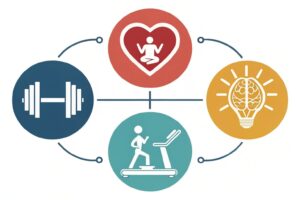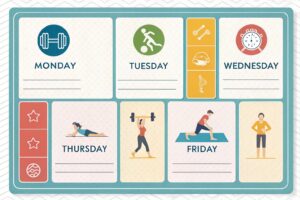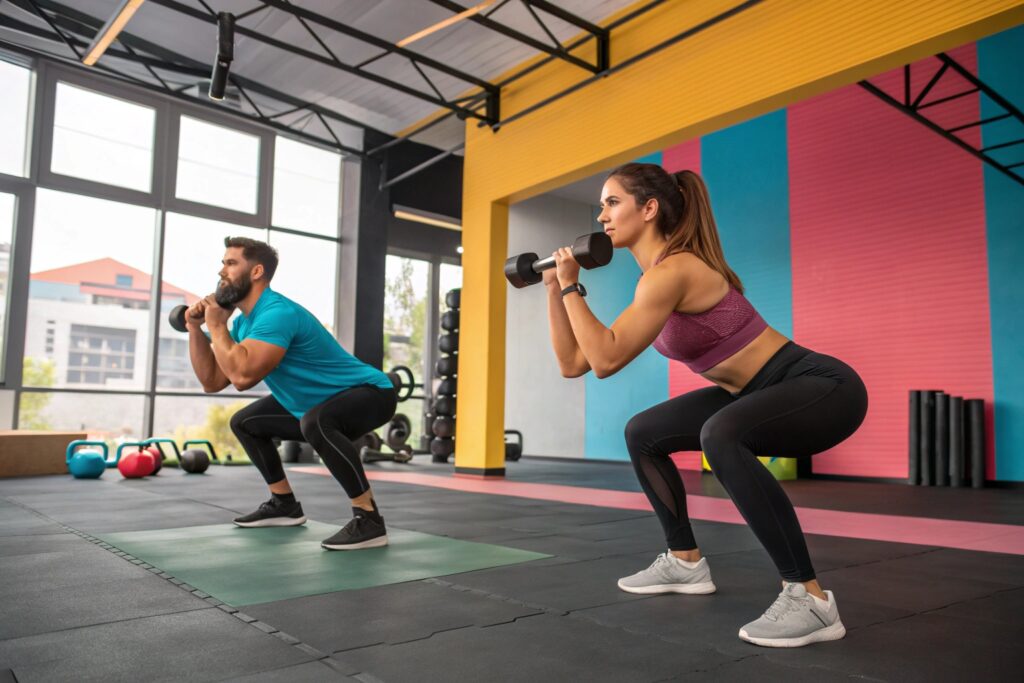Introduction
Transform Your Body, Transform Your Mind: The Ultimate Workout Guide is more than a catchy headline—it’s a proven roadmap that links physical movement with mental mastery. By integrating progressive training methods, science‑based nutrition, and powerful mindset tools, this guide shows you how to reshape muscle, burn fat, and rewire thought patterns all at once. Whether you’re a beginner or a seasoned athlete, the principles inside will help you ignite sustainable change, boost confidence, and unlock the high‑performance version of yourself.
In the pages that follow, you’ll find step‑by‑step workout blueprints, recovery strategies that protect your nervous system, and mental‑conditioning exercises that sharpen focus and resilience. Each section is designed to be practical, research‑backed, and adaptable to any schedule or equipment level. Let’s dive into the ultimate system that guarantees a stronger body and a sharper mind—starting today.
Section 2: Foundations of a Dual‑Focus Fitness Program
Why a Mind‑Body Approach Beats Traditional Training
Most gym‑goers chase visible results while ignoring the hidden driver behind lasting progress: mental stamina. Studies from the American College of Sports Medicine reveal that athletes who train cognition alongside physical exertion show a 15‑20% increase in adherence, faster skill acquisition, and reduced injury rates. By deliberately pairing mental drills—like visualization and breath control—with each workout, you create neuro‑muscular pathways that fire more efficiently, turning effort into measurable gains.
Key Pillars: Strength, Cardio, Flexibility, and Mental Conditioning
Your ultimate workout guide rests on four interlocking pillars:

-
- Strength Training – Builds muscle, boosts metabolism, and strengthens bones.
-
- Cardiovascular Conditioning – Improves heart health, accelerates fat loss, and enhances endurance.
-
- Flexibility & Mobility – Preserves joint range, supports recovery, and reduces chronic pain.
-
- Mental Conditioning – Elevates focus, reduces stress, and cultivates a growth mindset.
When these pillars are synchronized, you’ll experience a virtuous cycle: stronger muscles enable longer cardio sessions, better mobility fuels deeper lifts, and a resilient mind keeps you consistent through challenges.
Assessing Your Current Baseline
Before launching into any program, perform a quick self‑audit:
Physical Tests – 1‑rep max for major lifts, 5‑km run or 30‑minute bike test, and a functional mobility screen (e.g., overhead squat).
Mental Check‑In – Rate focus, stress, and confidence on a 1‑10 scale; note any negative self‑talk patterns.
Recovery Review – Track sleep hours, resting heart rate, and soreness levels for a full week.
Documenting these metrics gives you a clear starting point and a data‑driven way to measure transformation over time.
Section 3: Designing the Perfect Weekly Workout Split

Sample 5‑Day Split That Balances Strength, Cardio, and Mindfulness
Below is a flexible template that accommodates most lifestyles. Adjust weights, intervals, or meditation length to match your fitness level.
| Day | Focus | Key Movements | Mind‑Training Component |
|---|---|---|---|
| Monday | Upper‑Body Strength | Bench Press, Pull‑Ups, Overhead Press, Rows | 5‑min Visualization of perfect form |
| Tuesday | HIIT Cardio + Core | 30‑sec Sprint / 30‑sec Rest x 10, Plank Series | Box Breathing (4‑4‑6) during rests |
| Wednesday | Lower‑Body Strength | Squats, Deadlifts, Lunges, Calf Raises | Progressive Muscle Relaxation post‑session |
| Thursday | Active Recovery & Mobility | Yoga Flow, Hip‑Openers, Foam Rolling | Guided Mindful Stretch (focus on sensation) |
| Friday | Full‑Body Circuit + Mental Toughness | Kettlebell Swings, Push‑Ups, Jump Squats, TRX Rows | Cold‑Shower + 1‑min Mantra Repetition |
Periodization: When to Change the Stimulus
The body adapts quickly, so rotate your training focus every 4–6 weeks. Follow a three‑phase model:
-
- Accumulation (Weeks 1‑4) – Higher volume, moderate intensity, focus on technique.
-
- Intensification (Weeks 5‑6) – Lower volume, higher intensity, introduce advanced lifts.
-
- Realization (Week 7) – Deload, active recovery, mental‑skill refinement.
During the Realization week, replace heavy weights with light mobility work and extend meditation sessions to 15‑20 minutes. This systematic variation prevents plateaus and maintains mental freshness.
Adapting the Split for Home or Limited Equipment
If a gym isn’t accessible, swap dumbbells and bodyweight alternatives:
-
- Push‑ups → Hand‑release push‑ups or resistance‑band chest press.
-
- Squats → Goblet squats with a kettlebell or backpack filled with books.
-
- Rows → Inverted rows under a sturdy table or TRX‑style bands.
Even a minimal setup can still deliver the same mind‑body benefits when paired with structured breath work and visualization.
Section 4: Nutrition Strategies That Power Both Muscle and Mind
Macro‑Balancing for Optimal Performance
The classic “protein‑carb‑fat” split should be tweaked to match your training emphasis:
| Goal | Protein | Carbs | Fats |
|---|---|---|---|
| Strength & Hypertrophy | 1.8‑2.2 g kg⁻¹ | 3‑5 g kg⁻¹ | 0.8‑1 g kg⁻¹ |
| Endurance & Fat Loss | 1.6‑2.0 g kg⁻¹ | 4‑6 g kg⁻¹ | 0.6‑0.8 g kg⁻¹ |
| Mental Clarity | 2.0‑2.4 g kg⁻¹ | 2‑3 g kg⁻¹ (low‑glycemic) | 1‑1.2 g kg⁻¹ (Omega‑3 rich) |
Brain‑Boosting Foods for Focus and Mood
Incorporate the following nutrients daily:
-
- Omega‑3 fatty acids (salmon, walnuts, chia) – support neuronal integrity.
-
- Complex carbs with low glycemic index (sweet potatoes, quinoa) – steady glucose for cognition.
-
- Antioxidant‑rich berries – protect against oxidative stress caused by intense training.
-
- Magnesium (dark leafy greens, pumpkin seeds) – improves sleep quality and reduces anxiety.
Timing: Pre‑Workout Fuel and Post‑Workout Recovery
Pre‑Workout (30‑60 min): 20‑30 g fast‑digesting carbs + 10‑15 g protein (e.g., banana + whey shake). This spikes glycogen and primes neurotransmitter synthesis.
Post‑Workout (within 45 min): 30‑40 g high‑quality protein + 0.5‑0.7 g kg⁻¹ carbs (e.g., grilled chicken, brown rice, and mixed veggies). Add a teaspoon of creatine and a pinch of sea salt to replenish electrolytes and support cognitive recovery.
Hydration cannot be overlooked—aim for 35‑45 ml kg⁻¹ of water daily, plus electrolytes on sweat‑heavy days. Dehydration impairs both muscular power and decision‑making speed.
Section 5: Mental Conditioning Techniques That Accelerate Physical Gains
Visualization: The Neuroscience of Seeing Success
Functional MRI studies show that mentally rehearsing a movement activates the same motor cortex regions as physical execution. Spend 3‑5 minutes before each workout picturing perfect technique, breathing rhythm, and the feeling of completing each rep. Over time, this “neural rehearsal” reduces reaction time and improves lift efficiency by up to 12%.
Box Breathing for Stress Management and Performance
Box breathing (4‑4‑4‑4) stabilizes the autonomic nervous system, lowering cortisol and increasing heart‑rate variability—a marker of resilience. Use it during rest intervals, after cardio bursts, or in the evening to promote recovery. Consistent practice sharpens focus, reduces performance anxiety, and encourages a growth mindset.
Progressive Goal‑Setting: From Micro‑Wins to Macro‑Vision
Break your ultimate transformation into three tiers:
-
- Micro‑Goals – Weekly targets (e.g., add 2.5 kg to squat, hold plank 5 sec longer).
-
- Mid‑Term Goals – 6‑week milestones (e.g., run 5 km under 25 min, complete 10‑kg push‑up progression).
-
- Macro‑Goal – The overarching objective encapsulated in the title: “Transform Your Body, Transform Your Mind.”
Document each achievement in a journal, reflect on the mental shifts you experienced, and reward yourself with non‑food treats (new workout gear, a massage, a nature hike). This loop reinforces dopamine pathways associated with both physical and mental progress.
Cold Exposure & Mental Toughness
Cold showers or brief ice‑baths trigger norepinephrine release, sharpening alertness and enhancing mood. Pair a 2‑minute cold exposure after a demanding leg day; the physiological stress signal trains your brain to stay calm under discomfort, translating into greater perseverance during later high‑intensity sets.
Section 6: Recovery, Sleep, and Lifestyle Hacks for Sustainable Change
Sleep Architecture: Why 7‑9 Hours Isn’t the Whole Story
Deep (slow‑wave) sleep is when growth hormone peaks, repairing muscle fibers and consolidating memory—both crucial for body and mind transformation. Aim for 90‑minute sleep cycles, and incorporate “sleep‑window” hygiene:
-
- Dim lights 60 min before bed to boost melatonin.
-
- Avoid screens or use blue‑light blockers.
-
- Consume a small protein‑rich snack (cottage cheese or Greek yogurt) to prevent nocturnal catabolism.
Active Recovery Techniques That Accelerate Healing
On off‑days, integrate low‑intensity activities that increase blood flow without taxing the CNS:
-
- 30‑minute brisk walk or easy cycling.
-
- Dynamic mobility circuits (hip circles, thoracic rotations).
-
- Contrast showers (30 sec hot ↔ 30 sec cold) to stimulate vasodilation and flush metabolic waste.
Digital Detox and Cognitive Reset
Constant notifications fragment attention and elevate stress hormones. Allocate a “tech‑free hour” after each workout for journaling, reading, or meditation. This practice not only improves sleep quality but also trains the prefrontal cortex to maintain sustained concentration—an essential skill for both complex lifts and everyday problem‑solving.
Tracking Progress With a Holistic Dashboard
Create a simple spreadsheet or use a dedicated app that logs:
| Date | Workout Summary | Weight/Body Fat | Sleep (hrs) | Mood (1‑10) | Notes |
|---|---|---|---|---|---|
| 2025‑08‑20 | Upper‑body strength – 4×8 Bench Press | 78 kg / 14% | 7.5 | 8 | Felt strong, visualized perfect lockout. |
Review the data bi‑weekly. Correlations—like higher mood scores with better lift performance—highlight how mental states directly influence physical outcomes.
Long‑Term Lifestyle Integration
Finally, embed these habits into your lifestyle, not as short‑term “diets” or “programs.” Celebrate milestones, stay curious, and keep learning about new training modalities or mindfulness practices. When you consistently apply the principles outlined in Transform Your Body, Transform Your Mind: The Ultimate Workout Guide, the transformation becomes a sustainable identity rather than a fleeting achievement.
Ready to start your journey? Bookmark this guide, set your first week’s schedule, and watch the synergy between a stronger body and a sharper mind unfold—day by day, rep by rep.



